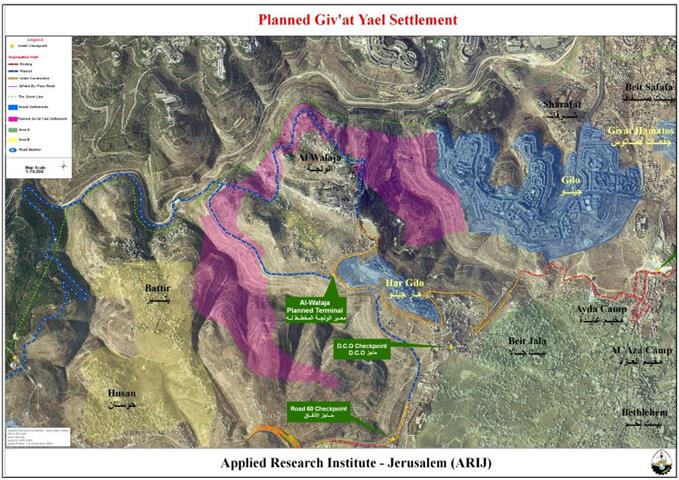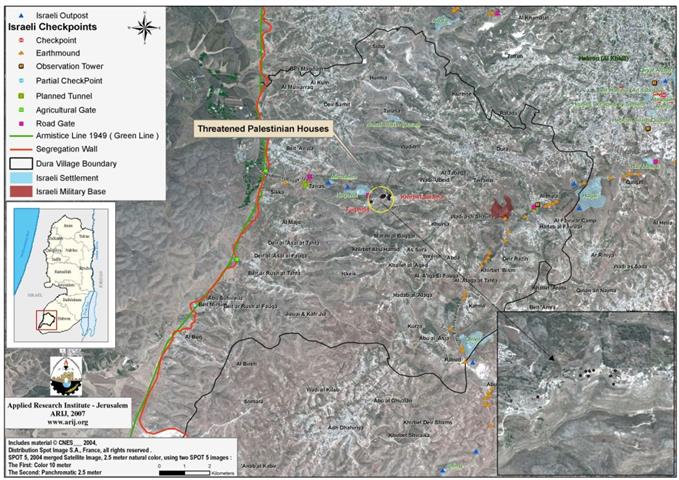On May 10, 2007, Israeli sources revealed that the Planning and Construction Committee at the Israeli Municipality of Jerusalem has officially approved the 2-3 years old plans to establish three new Israeli Neighborhoods in and around the city of Jerusalem. According to the committee, the plans will work to create a geographical link between settlements inside Jerusalem and those located to the south and to the north of the city, Gush Etzion Settlements Bloc, and Beit IL settlements bloc, but more importantly, the new neighborhoods addition will tighten the Israeli grip in and around the city by creating a chain of Israeli settlements roping the occupied city inside under the Israeli control.
This plan came to replace the controversial Safdie Plan (named after its planner Moshe Safdie) which sought to expand Jerusalem westward at the western side of the city on 24200 dunums of land and to locate the construction of 20,000 new housing units in the open areas.
Giv’at Yael Settlement
In the year 2004, the Israeli Municipality of Jerusalem announced a new colonial plan to construct a new Illegal Israeli settlement called 'Giv’at Yael' on nearly 5000 dunums of lands confiscated from the Bethlehem Western Rural villages of Battir, Beit Jala, and Al Walajeh northwest of Bethlehem Governorate. According to the Israeli plan, the settlement will have some 20,000 housing units to accommodate more than 55,000 Israeli settlers.
The Illegal proposed settlement of 'Giv'at Yael' will physically complete the ring of settlements that separate Jerusalem from Bethlehem and consequently from the West Bank’s southern territory. It will also close off the settlements’ line barrier across the northern parts of Bethlehem starting at Har Homa; east of Bethlehem to Giv’at Hamatos and Gilo north of Bethlehem then to Har Gilo, west of Bethlehem where the link is completed with the planned 'Giv'at Yael' settlement. After which the settlement ring continues southward to link with 'Gush Etzion settlements bloc in the southwestern part of Bethlehem Governorate. See Map 1
Map 1: Map of the Proposed Settlement of Giv'at Yael
Atarot Neighborhood
The other proposed site for a new Jewish neighborhood is situated north of Jerusalem in Atarot area, where plans to construct an 11,000 housing units neighborhood is approved by the Planning and Construction Committee at the Israeli Municipality of Jerusalem. The new neighborhood will be linked with the Illegal Israeli Settlements of Kochav Yacov and Bet Il (located to the northeast and north of the planned neighborhood) through an under road tunnel located at the northeast. See Map 2
Shimo’n Hatsedeeq Jewish Neighborhood
An additional new Illegal Jewish neighborhood is set to be located between Abu Dis village and the city of Jerusalem. An initial plan for the new neighborhood includes 500 housing units. The project for this neighborhood is privately funded and the Israeli municipality of Jerusalem has facilitate the confiscation process and the issuance of the demolishing order to privately owned buildings that were declared earlier as an absentee property.
Greater Jerusalem
Soon after the Israeli occupation of the Palestinian territory, including East Jerusalem, the consecutive Israeli governments adopted one constant policy toward Judaization of Jerusalem by intensifying settlements programs inside and on the newly declared Israeli boundary of the occupied city. Over the following years, project to establish new settlements and expand existing ones continued insistently with an aim to realize the Israeli dream of Greater Jerusalem with a demographic Jewish superiority, also to isolate the city from its non-Jewish traditional links and surroundings. The Israeli Illegal constructions were concentrated mainly inside the Old City and three settlements blocs surrounding the occupied city: Ma’ale Adumim, east of East Jerusalem, Giv’at Ze’ev in north and Gush Etzion southwest of Jerusalem inside the boundary of Bethlehem Governorate.
On the ground these three Illegal Israeli settlements blocs occupy 2.7% of the total West Bank area and holds nearly 70% of the settlers of the West Bank Illegal Israeli settlements. See Map of Greater Jerusalem
Peace & Settlements Don’t Go Together
Over the years of the peace process, it became evident that Israel has no intention for a just and durable peace with the Palestinians, especially that the settlements program has intensified during the years of the so-called peace process to unprecedented level, and know with the Segregation Wall, Israel is attempting to consolidate its control on as much possible lands of the occupied territory, particularly in East Jerusalem where the overall number of settlers has doubled during that same period.
The Israeli policy of expanding the Illegal Israeli settlements in the Occupied Territory has always been the main obstacle to achieve peace, as it undermines all the regional and International efforts to conclude a peace agreement between the Israelis and the Palestinians where two states lives in peace side by side.
Legal & International Status
The following are some indications on how the settlements are reject and perceived as an obstacles to peace by the international community and the international humanitarian law.
-
The UN Security Council Resolution 465 of 1980 Determines that all measures taken by Israel to change the physical character, demographic composition, institutional structure or status of the Palestinian and other Arab territories occupied since 1967, including Jerusalem, or any part thereof, have no legal validity and that Israel's policy and practices of settling parts of its population and new immigrants in those territories constitute a flagrant violation of the Fourth Geneva Convention relative to the Protection of Civilian Persons in Time of War and also constitute a serious obstruction to achieving a comprehensive, just and lasting peace in the Middle East.
-
UN Security Council Resolution 242 (1967) calls for Israel to withdraw completely from territories it occupied. The settlements are the biggest obstacle to implementing this resolution.
-
Mitchell Report (May 2001), one of the most important steps towards easing the current situation and leading to a peaceful solution in the long-term is for the Israeli government to freeze all settlement activity, including the 'natural growth' of existing settlements.
-
In May 2001, the head of the International Red Cross delegation to Israel and the Occupied Territories said that settlements are 'equal in principle to war crimes'. (Note: 'The transfer, the installation of population of the occupying power into the occupied territories is considered as an illegal move and qualified as a 'grave breach.' It's a grave breach, formally speaking, but grave breaches are equal in principle to war crimes', Rene Kosirnik, head of the ICRC delegation to Israel and the OPT, press conference 17 May 2001.) .)
Prepared by
The Applied Research Institute – Jerusalem
ARIJ

















